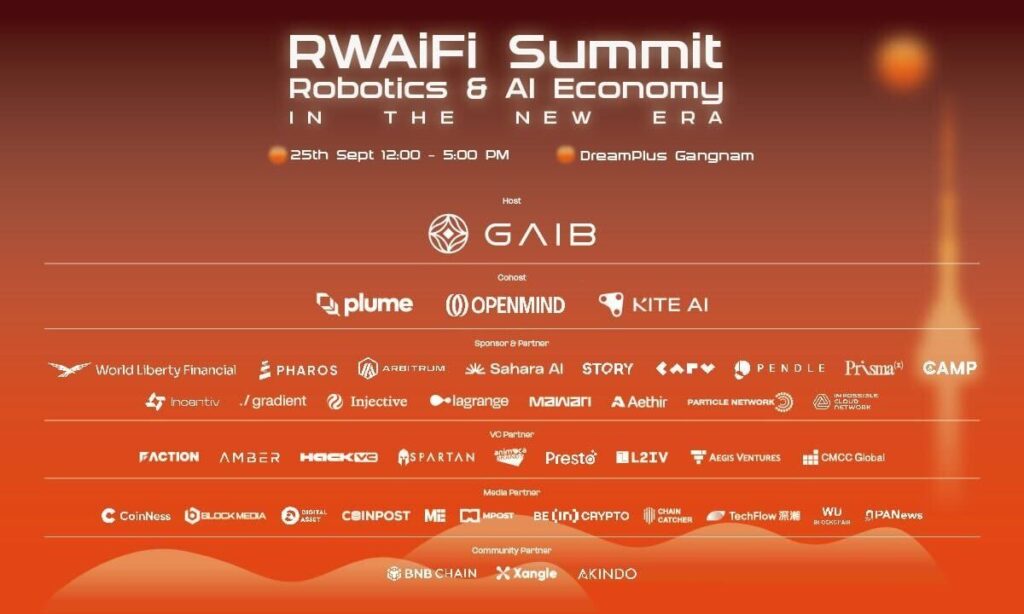The RWAiFi Summit, hosted by GAIB, successfully concluded on September 25 in Seoul, attracting over 400 participants and bringing together 20 top-tier ecosystems and projects, including Plume, OpenMind, Kite AI, Pharos Network, Arbitrum, BNB Chain, Story Protocol, CARV, Pendle, PrismaX, Camp Network, Incentiv, Injective, Lagrange, Mawari, Aethir, Particle Network, ICN Protocol, etc. The event was supported by well-known investment institutions such as Faction VC, Amber Group, Hack VC, Spartan Group, and L2 Iterative Ventures. Together, they witnessed the convergence of AI, robotics, debt, and explored new opportunities brought about by computing power, scalable robotics, and financialisation of real-world assets.
Robotics: From research and development to scalability
The summit focused on the implementation and expansion of an AI-driven robotics economy. AI-equipped robotics has moved from the R&D stage to a large-scale deployment. By integrating with on-chain financial tools, robotics infrastructure and hardware procurement can turn capital into tangible productivity more quickly, with access to more efficient funding channels.
This not only unlocks new industrial dividends, but also provides investors with the first opportunity to directly share the benefits of the robotics economy through on-chain mechanisms.
Rwaifi: The Financial Foundations of the AI Economy
With the rapid rise in the AI economy, demand for computing power and hardware is growing at an unprecedented pace. Finding efficient, transparent and scalable funding solutions for these critical assets has become an urgent challenge for the industry. GPU computing power, robotics hardware and related cash flows are emerging as new frontiers of on-chain financialization. By transforming infrastructure investments, with chain assets that anyone can participate in, allowing access only to institutions, this approach provides a flexible infrastructure funding channel while allowing retail investors to share the industry’s growth dividend for the first time.
As a major project for Rwaifi trucks, Gaib demonstrated how GPU and robot profits are tokenized and how capital flows through AID quickly and efficiently into the AI industry. This model significantly reduces funding costs and makes it one of the best practices in the RWAIFI model, while allowing investors to directly share stable returns backed by real-world assets in the chain.
Guyve’s Vision
By bringing AI benefits on-chain, Gaib finances GPUs and robotics through AID, enabling investors, businesses and developers to seamlessly participate in the AI economy.
With the collective efforts of partners and communities, this summit was not only a major industrial exchange, but also a new phase in the Rwaifi story. Against the backdrop of rapidly growing global demand for the AI economy and the accelerated adoption of AI robots, Rwaifi is gradually becoming an important bridge connecting real-world cash flow with on-chain financial systems.

host:
Gaib is the economic layer of AI infrastructure, making computing and robotics economy on-chain. By tokenizing enterprise-grade GPUs and robotic assets with cash flow, Gaib will unlock Capital for Neo-Cloud, Datacenters and Robotics Innovators while providing investors with direct access to AI Infra Investments and Real Regies.
Through AID, Gaib’s AI Synthetic Dollar, investors can seamlessly access the AI economy while earning real returns from AI-powered computing.
Co-host:
Plume is a publicly-exposed EVM-compatible blockchain built for the next evolution of real-world assets (RWAS). They’re not just tokenizing assets, but they’re creating seamless ways like stakes, swaps, lending, borrowing, looping, and more like Crypto.
By integrating facility-grade assets with distributed financial (DEFI) tools, Plume makes traditional inaccessible assets, such as private credit, ETFs, and goods, unauthorized, complex, and click-away.
OpenMind builds a universal operating system for intelligent machines. Its OM1 platform allows robots of all forms to perceive, adapt and act in human environments. The distributed coordinating layer, fabric creates the identity of a secure machine and operates a global network in which intelligent systems work together. Together, they lay the foundation for machines that can operate in any environment, maintaining security and coordination at scale.
Kite AI is an EVM compatibility layer-1 blockchain designed for AI and agent internet, addressing three core challenges of agent native identity and authentication, governance and payment. This allows portable, interoperable, and reputation-based agent identities, allowing seamless interaction between services with encryption simplicity, and replacing complex authentication systems. Kite AI also offers programmable permissions and context-aware approval for autonomous pharmacist governance. Additionally, it supports instant Stablecoin-Native machine-to-machine micropay with near-zero fees, streamlining payment infrastructure for efficient transactions in an AI-driven economy.


